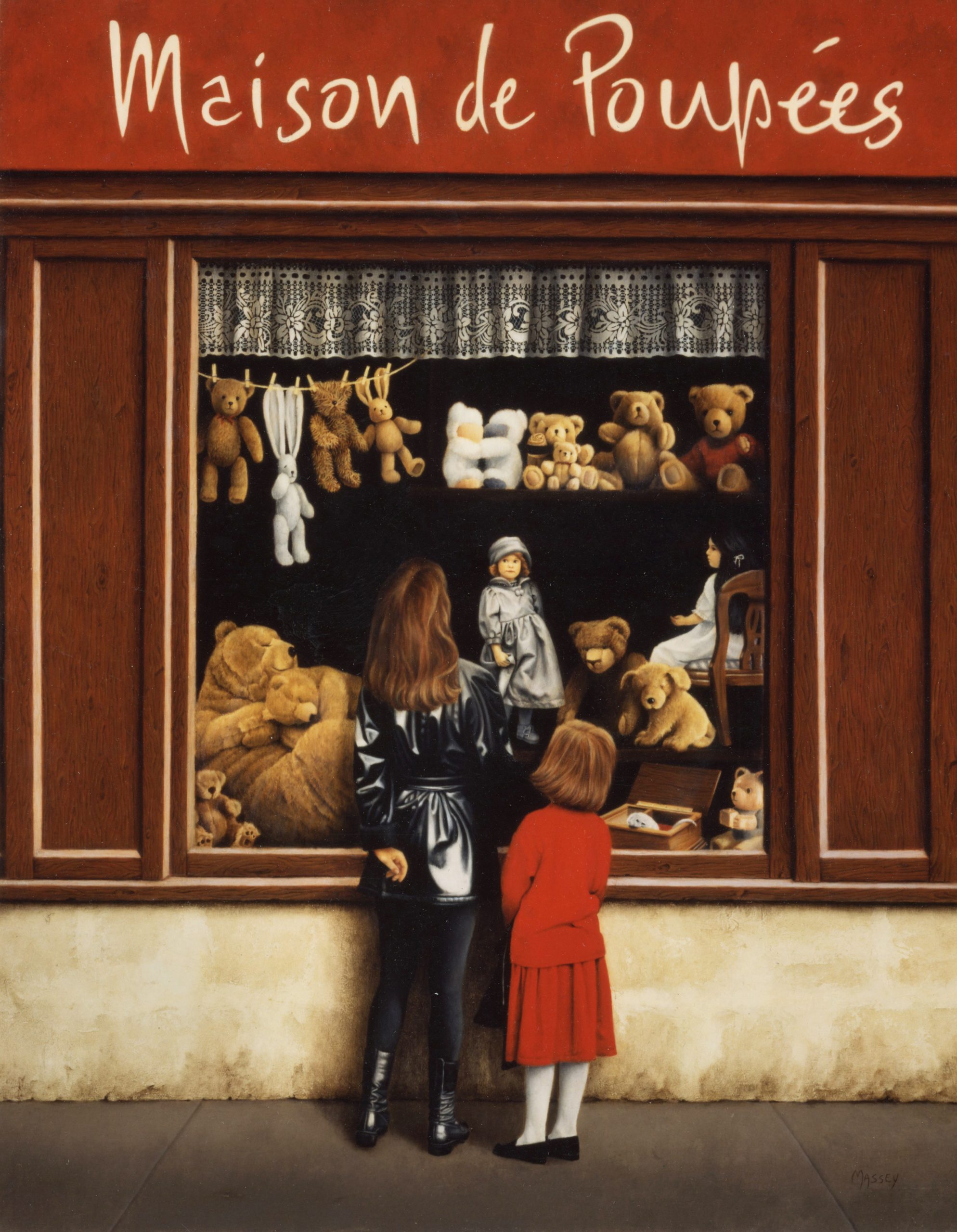
20in x 16in | 50.8cm x 40.6cm
Oil on mahogany board
Collection of Sharon Verlander
Hover over the image to zoom in and see the detail or Click to view the full size image in a new tab
For the story behind the painting, scroll down or click here
Available for Purchase
-
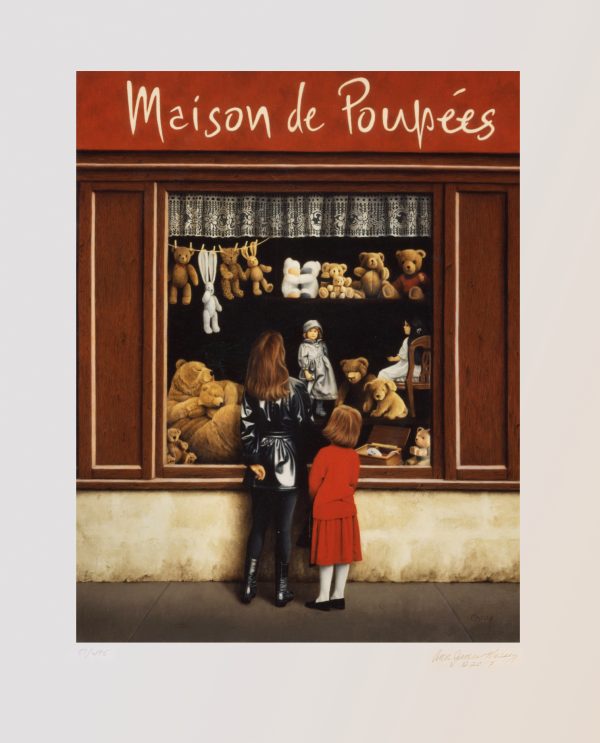
La Maison de Poupées Signed & Numbered Offset Lithograph
$275.00Add to cartLimited edition of 495 offset lithograph prints, individually signed and numbered by the artist. The image measures 16in x 20in. The print measures 21in x 26in and comes shipped, rolled with acid-free tissue and a Certificate of Authenticity in a sturdy mailing tube. Published by Massey Fine Arts, USA
-
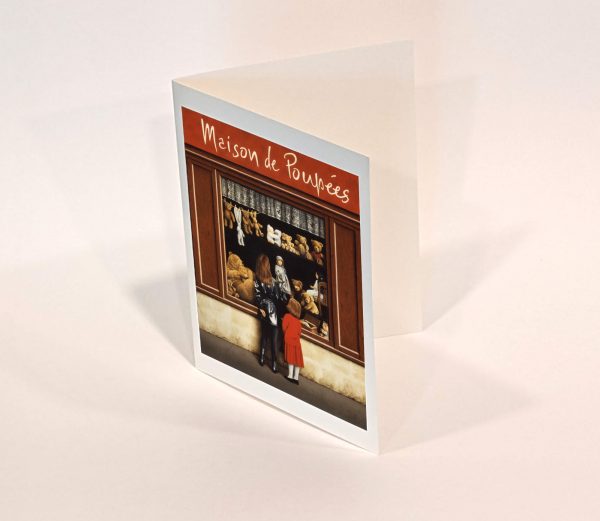
La Maison de Poupées Note Card
$4.00Add to cartFolded note card. Blank inside, ready for any occasion. Measures 7in x 5in closed and includes an envelope.
-
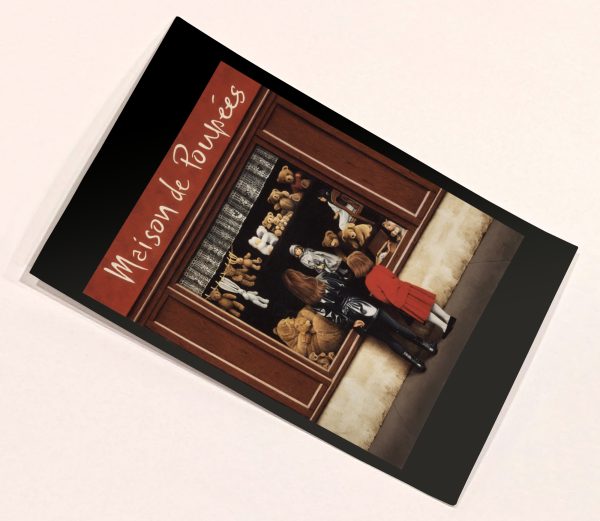
La Maison de Poupées Post Card
$1.50Add to cartFlat post card. Blank on the back. Measures 6in x 4in.
-
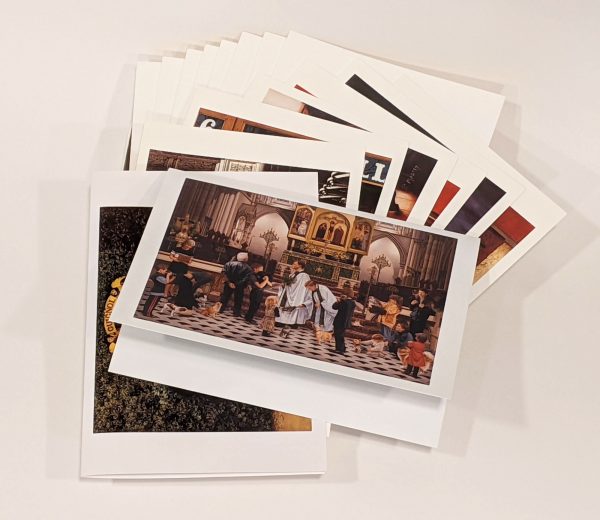
Oil Painting Note Card Set (set of different 8 images)
$20.00Add to cartSet of 8 folded note cards including, “The Blessing of the Animals”, “The Marionette Theatre”, “The Connoisseur”, “La Maison de Poupées”, “Christmas in Paris”, “The Marionette Shop”, “Day’s End”, and “The Fisherman Mending His Net” Blank inside for any occasion. Measures 7in x 5in folded, including 8 envelopes.
Awards
The Barbara Tate Award for an Oil Painting
The Society of Women Artists 141st Annual Exhibition, London, ENGLAND
John R. Grabach Memorial Award for an Oil
The American Artist Professional League 71st Grand National Exh., Salmagundi Club, New York, NY
Sixth Place in the Landscape with Life Category (tied)
American Art Awards 2020 (online)
Reproduced in Magazines
“From El Paso to Paris” article by Cindy Graff Cohen, El Paso Inc. Magazine (Summer 2018)
InformArt (Spring 2002)
El Paso Life (May/June 2002)
Behind the painting
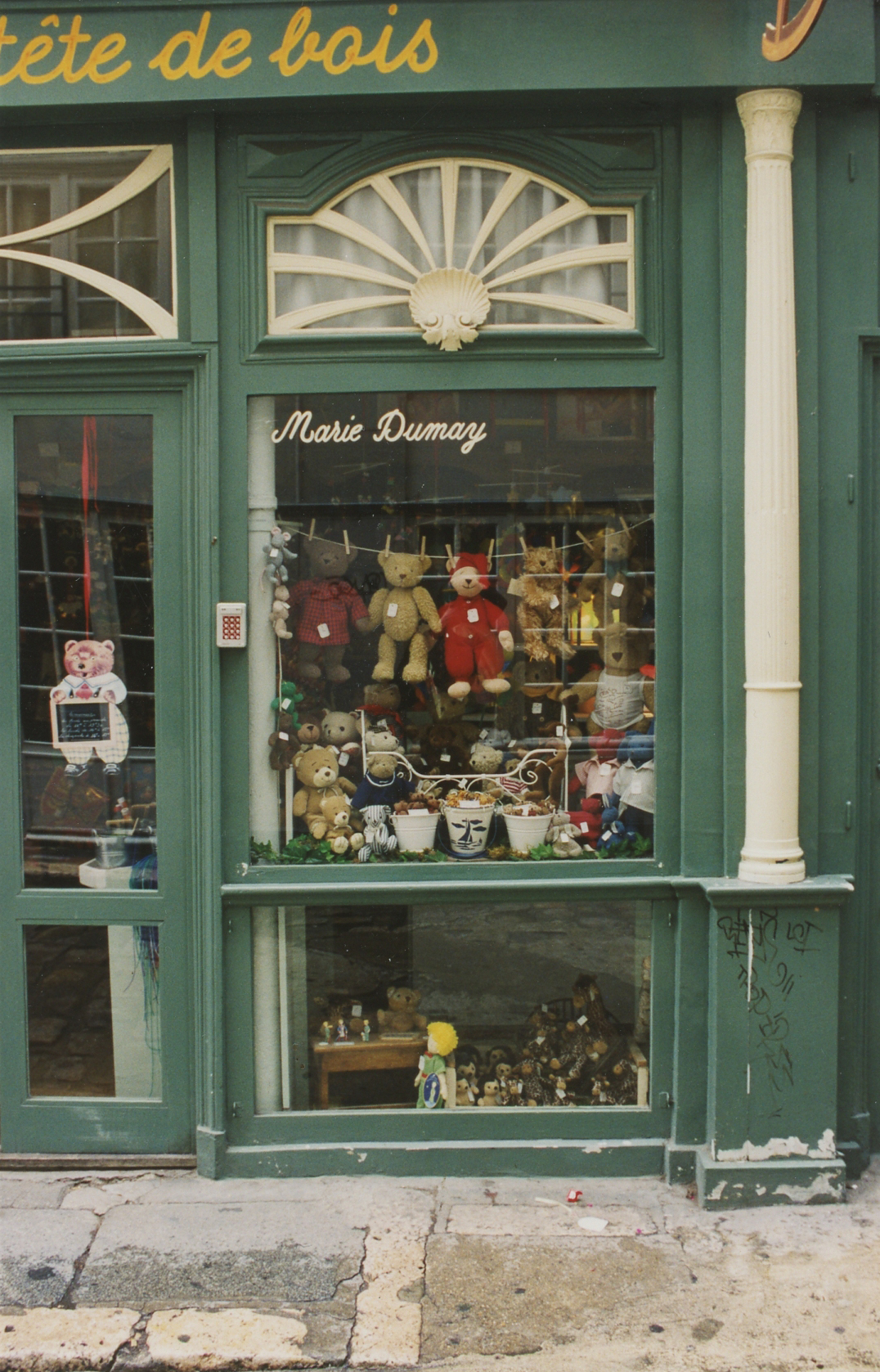
The toy shop on the Cour du Commerce -St-André
Photo ©1998 Ann James Massey
It is both pleasing and amusing when someone comments that they have seen the original shop that they believe is in my painting La Maison de Poupées. Pleasing because the shop looks real. Amusing because the shop exists only in my imagination with most of the elements being autobiographical.
Ever since I discovered a delightful shop (pictured here but now unfortunately gone) next to the Café Procope (founded in 1685 and patronized by Benjamin Franklin) on the tucked away Cour du Commerce-St-André, the idea of painting a toy shop intrigued me. However, neither that shop nor the dozen others I found over the next two years fit my mental picture. Instead, my search brought me back to myself, with some ideas on subjects gleaned along the way.
The moment I conceived the idea, I knew personal elements would be incorporated, especially teddy bears that have taken on a special meaning for me in Paris.
My first trip to Paris in 1976 was on a Maupintour tour of France as a traveling companion to Gray Nicholson, my grandmother’s cousin. Our tour director, Henrí Bérenger, was brilliant and I kept in touch with him on and off over the years. After he mentioned offhandedly that he had been in a motorcycle accident and had suffered a broken collarbone plus half a dozen broken ribs, I bought him a stuffed bear. I bound up the chest, bandaged one paw, put the paw in a fashioned sling, and sent him this “get well” bear. When I moved to Paris, this dear man still had the bear by his bed, explaining simply “only you would do that.” A year after my arrival, I purchased a tiny bear as a companion to his bear. My most cherished friend and mentor is now my “better half” and my muse (you can see his image in my other works: The Connoisseur, The Blessing of the Animals and in a wax pencil portrait). Our counterpart bears are in this painting, on the top shelf next to the white bears.
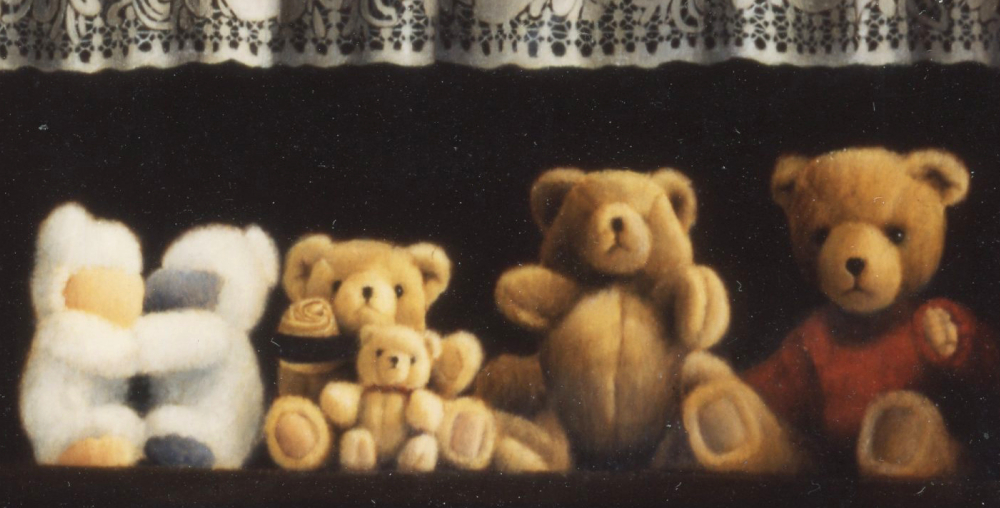
The white bears are a testimony that two time Oscar winner Olivia de Havilland (1916-2020) has given more than her time as a lay reader on Christmas and Easter for the American Cathedral, the Episcopal church I belong to in Paris. For their capital campaign in 1996, Miss Havilland generously donated her collection of teddy bears that had been given to her over the years by her co-star Ida Lupino in “Devotion”, in which they respectively played the writers Charlotte and Emily Bronté (in my teens, I read “Wuthering Heights” three times and “Jane Eyre” twice and was delighted to discover that they were equally important to Henri). The moving circumstances of their friendship were shared with the parishioners, making the bears priceless in our eyes. During the auction, I saw the two bears with pink and blue markings, sewn together in a hug and I knew they belonged to us. Thus, we became the happy owner of a pair of Olivia de Havilland / Ida Lupino bears. These bears also denote Paris for me, both in the closeness they depict, plus the kindness of a gracious lady and world famous actress.
On the other side of the “get well” bear is a bear I purchased while traveling with some friends. When I returned to the hotel, The Lodge in Cloudcroft, New Mexico, I tossed the bear on a chair in the corner of my hotel room and went to dinner. Upon my return to the room, I found the bed turned down, and instead of the usual mints, there was the bear, gently tucked into the bed: his head on the pillow, the covers pulled up to his neck and his paws resting on top. The remembrance of another dear friend long far away, the chambermaid’s sense of humor, plus the bear’s fat tummy guaranteed this stuffed toy’s placement in the painting.
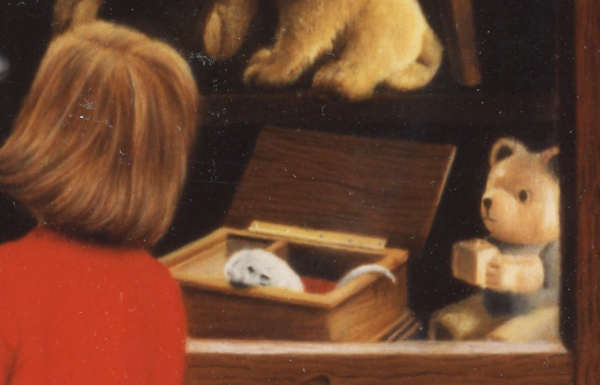
©1999 Ann James Massey
Though my dad, Fred James, was an engineer by profession, he was also an excellent carpenter and prepared the sapele mahogany boards on which I paint. During his final illness in the hospital, and though he was hardly able to speak after being taken off the respirator, Dad looked up at me and the first thing he said was, “Do you need any more boards?” In the early 90’s, Dad made lovely, simple music boxes for his girls: Mom, my sister Susan and me. This precious gift is depicted on the bottom shelf…and his other gift is the board upon which the composition is painted. For more about my father, please read Behind the Painting for In Memoriam in the miniature gallery).
Originally, I had a different bear in front of the cuddling, sleeping ones, but he wasn’t compatible with the others and fought constantly…so I kicked him out. Though I auditioned numerous bears, I didn’t find the perfect replacement until my next trip to England. I was searching for Henrí’s ancient, but active Catholic church that he had attended during his London years. After the successful completion of my quest, I walked around a corner and saw a bear in a shop window who cried out “choose me!”. From that moment, she became my St. Etheldreda Bear From Ely Place and is now tucked in the left corner of my shop window.
Dale Kaufman-Moore, a friend and former cousin in-law from my hometown of El Paso, Texas, was the model for the young woman, albeit with a modified body and clothing as she was pregnant when she posed for me (she and her son Maxwell are also in The Blessing of the Animals).
Almost all the other toys have been altered a bit for composition, design, and copyright concerns. The store lettering (literally, House of Dolls, with a nod to Ibsen) is based upon Henrí’s handwriting.
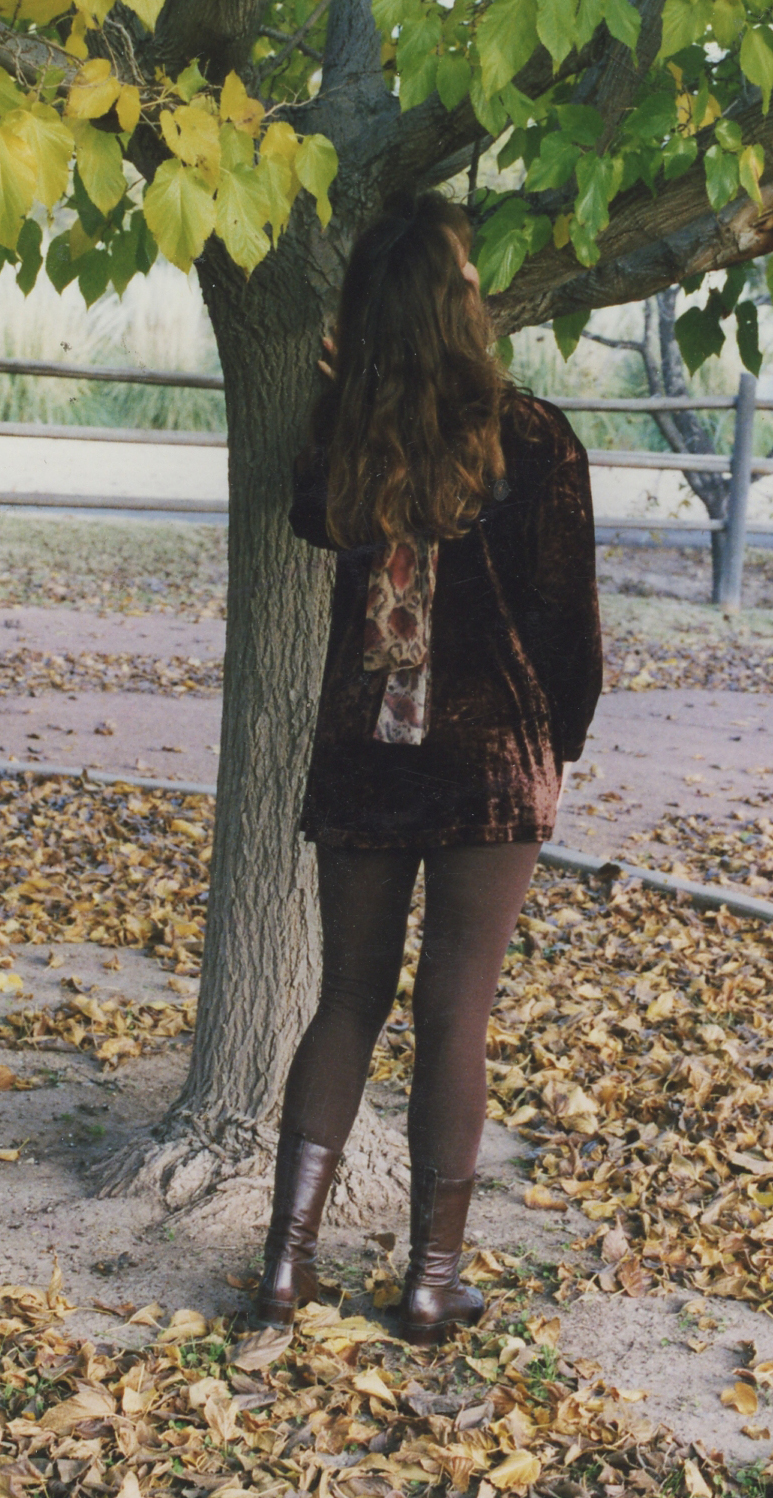
Photo ©1997 Ann James Massey
In planning my composition, I have again utilized the classical triangular composition of the Old Masters, though inverted: the broad red sign, through the red neck ribbon on the left bear and close to the red sweater on the right bear on the top level, to the red velvet lining in the music box and ending in the children’s red outfit. The motif is repeated in white with the lace curtains, through the rabbit on the left and the seated doll’s white dress on the right, then to the leather coat and the toy rat, culminating in the bright white stockings (the shine on the leather boots is de-emphasized by the heavy shadowing). You can even extend the white themed inverted triangle to the cream letting in the sign.
The use of two upside down triangles in such a bold fashion normally would result in a top heavy atmosphere threatening to tilt the composition forward, but I’ve balanced it by literally grounding it with the dark sidewalk and pulling the eye back upwards with the contrasting light rock and mortar wall. Notice that the light straight horizontal and vertical lines of the wood further hold the composition firmly in place.
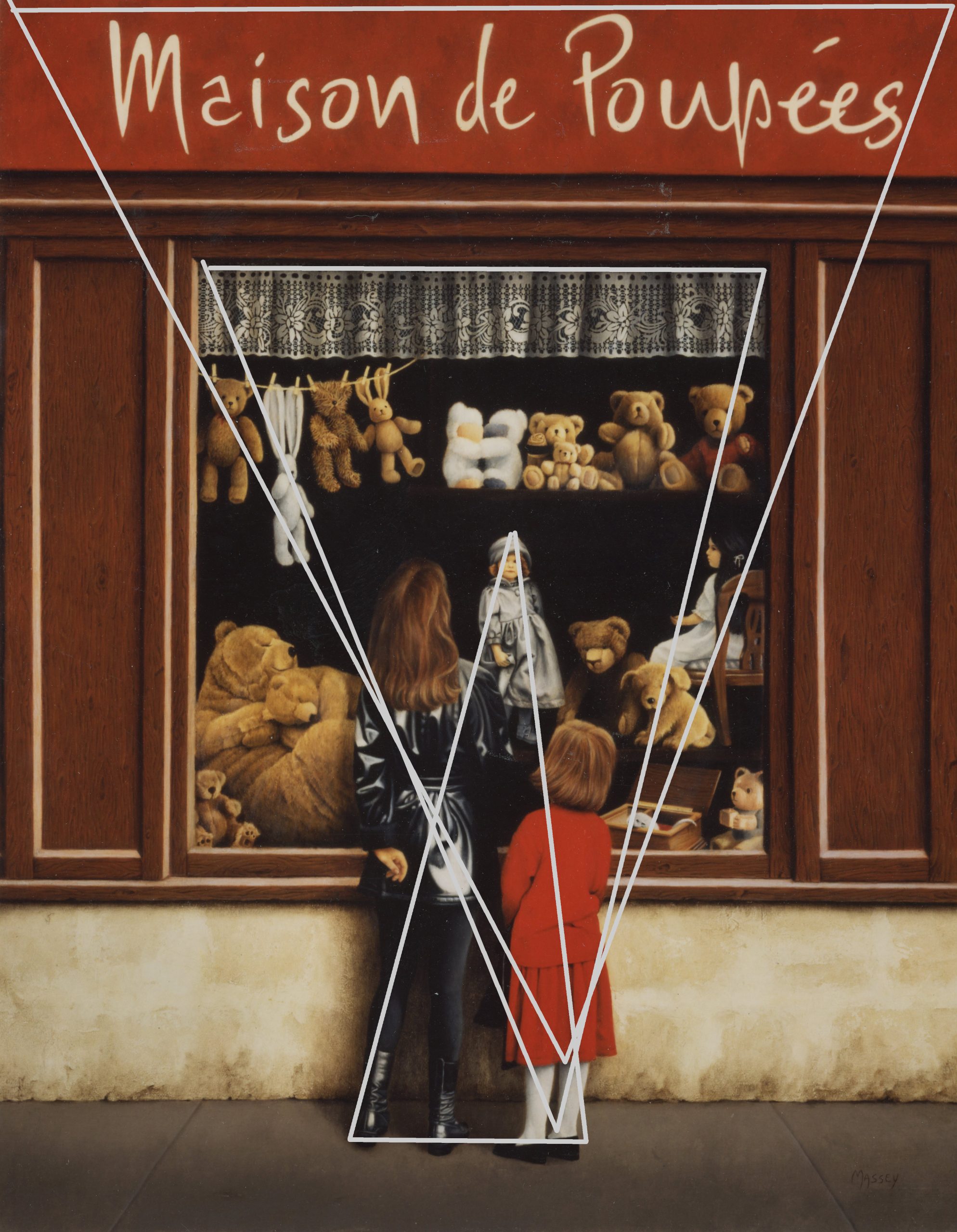
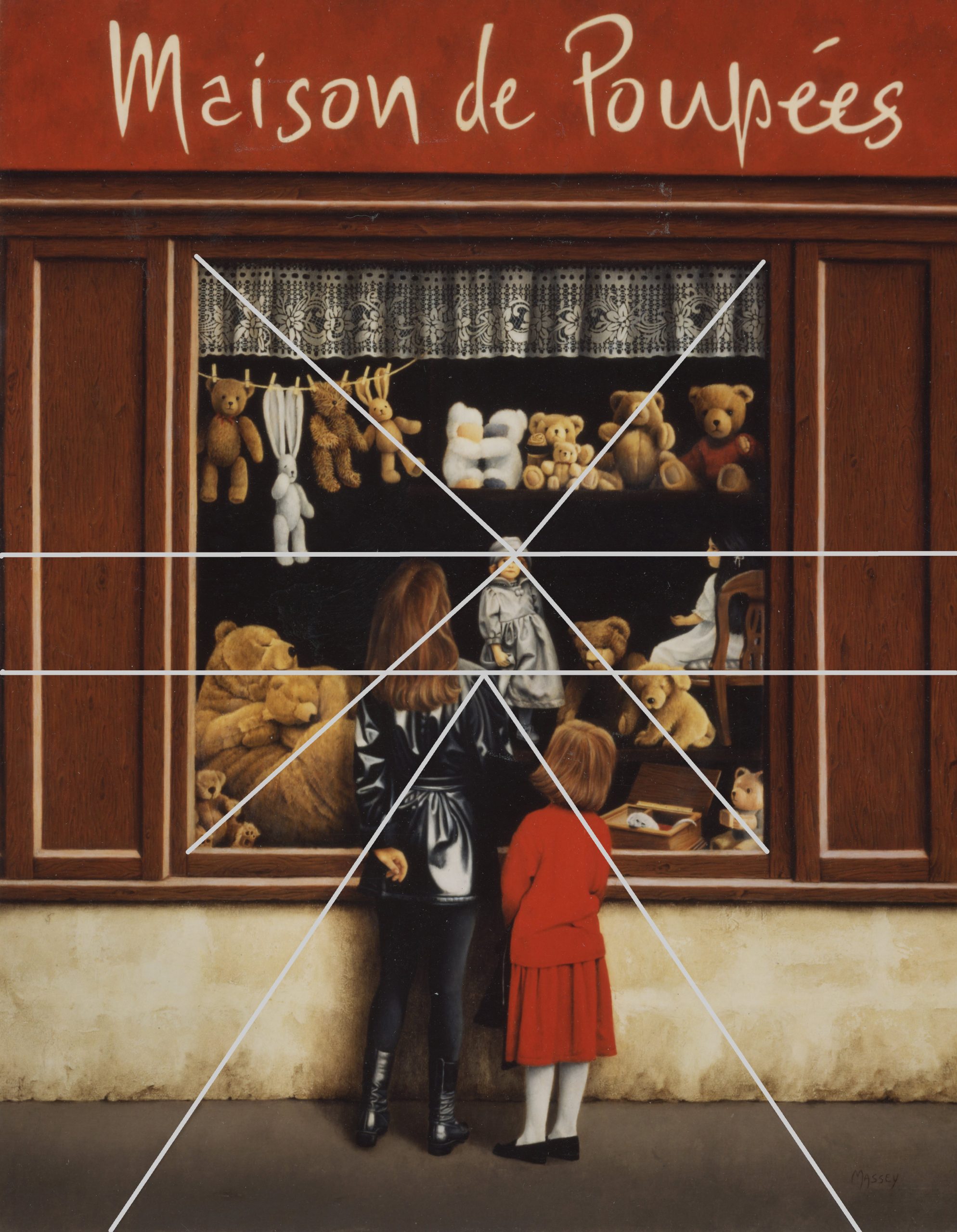
I have once again skewed perspective slightly, as did the Old Masters (Veronese and The Wedding at Cana) to eliminate a slight feeling of a fishbowl look. Because the composition is so near but tall, I have utilized two eye level lines, one for the window (at the doll’s eye level) and another lower one for the sidewalk (at the young woman’s shoulder).
Great consideration was given to the placement of all the toys and the participants so that the eye would continue to move throughout the image without becoming fixated and stopping on one spot, like the intricate lace curtains. The middle doll looking directly at the young woman was the key, forming a tight long traditional triangle with her and the child. Observe that traditional focus is slightly off center (as is the window), to create more interest (perfectly bisected compositions are more boring to the eye). Without mentioning each toy, note the angle of placement always moving inwards or maintaining the middle position to keep the eye moving inside the imagery. See also the teddy bear almost caressing the child’s head, with the dog and rat also gravitating to the young girl. This is a gentle nod to my love of animals from an early age…having had cats, rats, gerbils, birds, dogs, horses, even a crippled chicken, etc. in my youth…but at present with only one cockatiel, Cleo, sharing my tiny Parisian apartment and studio.
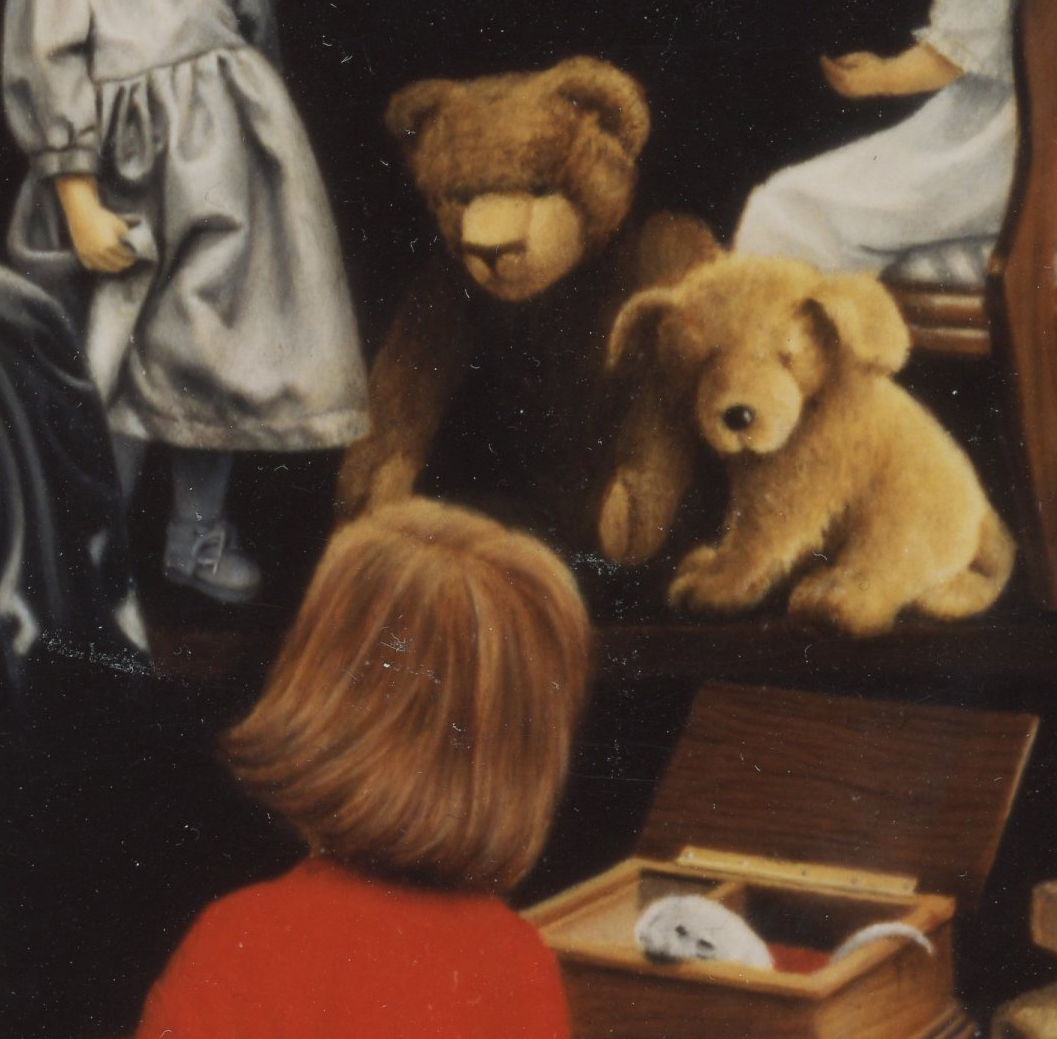
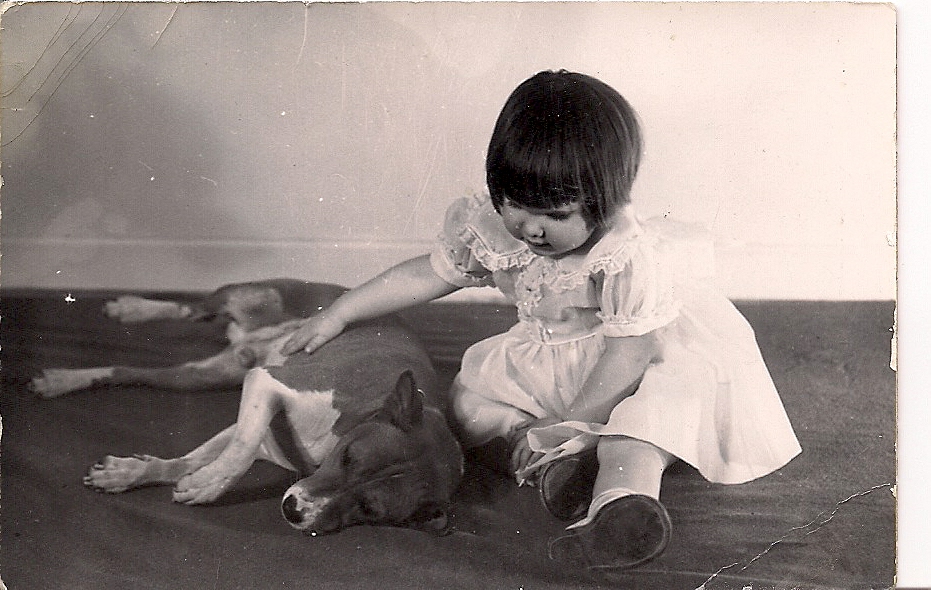
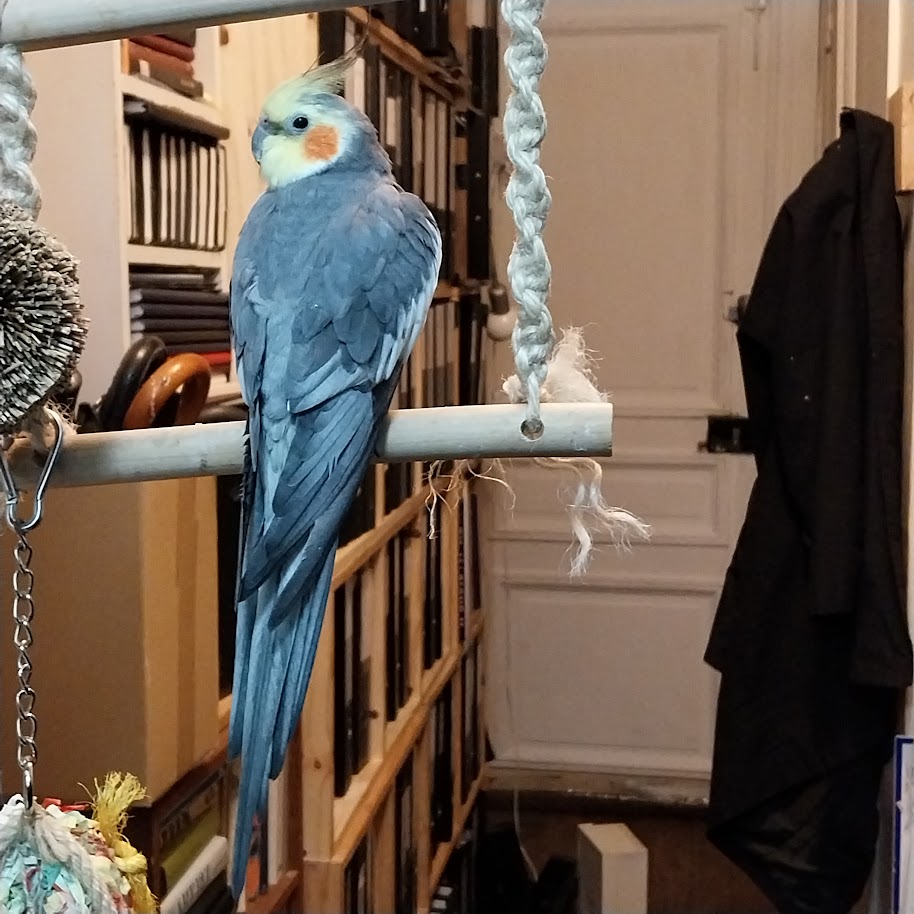
For those who search for “meaning” in art, not to worry…it is in the composition. The typical French school girl looks at and dreams of owning the doll; the doll looks at and dreams of becoming the young woman; the young woman looks at my bears and dreams of love, art and Paris. The child resembles a young me (though I collected horse figurines and books rather than dolls) and the red outfit is significant to a story of my toddler days (referenced in Behind the Art for The Marionette Theatre). The young woman bears a passing resemblance to me in my long-haired youth, thus the painting signifies the beginning but not the ending, of my dreams realized.


